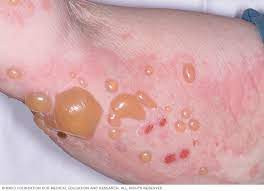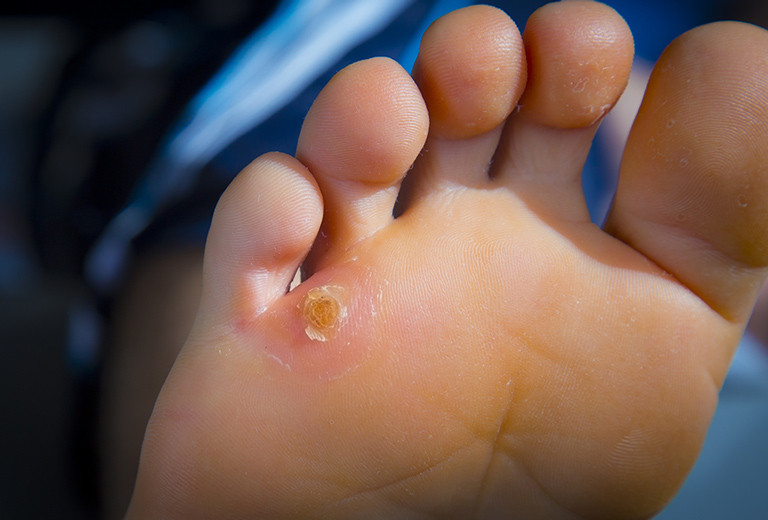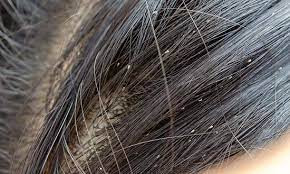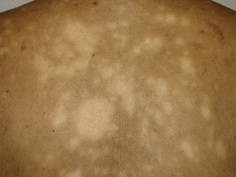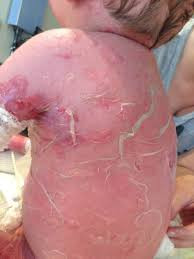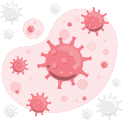Definition
Pemphigoid presents itself as a rare autoimmune disorder marked by the manifestation of skin rashes and blisters on both the skin and mucous membranes. An autoimmune disorder is a state wherein the immune system designed to combat foreign agents, wrongly targets its healthy cells. While pemphigoid may manifest across various age groups, including children, it predominantly affects the elderly.
Causes
Pemphigoid arises from dysfunction of the immune system whereby healthy cells or tissues are targeted. In this condition, antibodies produced by the immune system target the tissues situated beneath the superficial layer of the skin. Consequently, this leads to the detachment of the superficial skin layer from the underlying tissue, resulting in the formation of painful blisters. The precise cause behind this mechanism in pemphigoid patients' immune system remains unknown.
While in the majority of cases, pemphigoid onset lacks a specific trigger, there are occasions where specific factors may trigger its development, such as:
- Some medicines, for example, diuretics (used to remove excess fluid in the body) or certain antibiotics such as penicillin, have been identified as potential contributors to pemphigoid onset.
- Radiation therapy
- Phototherapy utilizing ultraviolet light
- Wounds or injuries on the skin, particularly serious wounds, infections, or burns
- Psoriasis, characterized by persistent inflammatory activity in the skin
- Neurological conditions like Parkinson's disease or dementia
- Grave's disease, an autoimmune disorder characterized by the excessive production of thyroid hormones
Risk factor
People affected with other autoimmune conditions could have an elevated risk of pemphigoid. Furthermore, advanced age and females are associated with an increased risk of pemphigoid development. Notably, the risk of pemphigoid escalates significantly beyond the age of 70.
Symptoms
Symptoms of pemphigoid typically manifest as fluid-filled blisters predominantly found on the legs, arms, and abdominal region. Additionally, the blisters may extend to the mucous membranes. Mucous membranes serve to safeguard internal bodily surfaces through mucus secretion. Because of that, pemphigoid can occur in various regions, including the eyes, nose, mouth, and genital areas.
Pemphigoid is classified into several types characterized by the specific areas affected and the timing of their occurrence. These classifications include:
Bullous pemphigoid
Bullous pemphigoid represents the most prevalent type of pemphigoid. Symptoms primarily feature the occurrence of skin blisters, predominantly observed on the extremities including the arms, legs, and areas surrounding the joints, then the groin, armpits, and lower abdomen. These blisters usually do not easily break, often surrounded by reddened skin, accompanied by intense itchiness. However, there are instances where the surrounding skin of the blisters are normal. The size of these blisters can range from a few millimeters to centimeters.
Despite the pain this condition causes often, scarring is not commonly found. Recurrence followed by asymptomatic intervals characterizes the disease course for most individuals with bullous pemphigoid, which may persist over an extended duration, spanning years. Approximately 10-40% of affected people also present with symptoms that affect their mucous membranes. While relatively uncommon, bullous pemphigoid stands as the primary cause behind blistering skin conditions in individuals aged 65 and older.
Mucous membrane pemphigoid
Mucous membrane pemphigoid, also known as cicatricial pemphigoid, is characterized by the exclusive formation of blisters on the mucous membranes lining various areas of the body, including the oral cavity, eyes, nose, throat, and pubic region. Predominantly affected areas are typically the mouth and eyes; however, involvement of the scalp, face, and neck may occur in some people, approximately 25-30% of cases of cicatricial pemphigoid. Initial presentation often features rashes and blisters within the mouth, with subsequent spread to other mucosal surfaces if left untreated. The formation of blisters may lead to the development of significant scarring, potentially resulting in pronounced cosmetic alterations. Onset of mucous membrane pemphigoid commonly occurs between the ages of 40 and 70 years, with a higher predilection observed in women and individuals with compromised immune function.
Pemphigoid gestationis
Pemphigoid gestationis, formerly known as herpes gestationis despite lacking association with the herpes virus, refers to the emergence of blisters during or shortly following pregnancy. This condition typically manifests abruptly towards the end of pregnancy but may manifest at any stage of pregnancy. Pemphigoid gestationis incidence is estimated at approximately 1 in 50,000 pregnancies.
Primarily affecting white women with a history of prior pregnancies and contraceptive pill usage, pemphigoid gestationis presents with itchy blisters predominantly on the upper body. The initial symptoms often resemble hives-like lesions, notably concentrated around the abdomen, particularly surrounding the navel, subsequently spreading to the torso and limbs. Following an initial phase, blister formation may assume a circular pattern. Scarring is uncommon unless secondary infection occurs. In less than 5% of cases, transmission from mother to fetus is possible. Recurrence may occur during or shortly after childbirth.
The presentation, extent, and onset of symptoms could vary across people and various types of pemphigoids. However, certain characteristics of the blisters remain consistent irrespective of their location on the body, including:
- Reddish rashes typically manifest preceding the appearance of blisters
- Blisters exhibit a considerable size and are filled with clear fluid, although occasionally the fluid could be reddish (bloody)
- Blisters possess thick walls that do not rupture easily
- The surrounding skin around the blisters may appear normal, slightly reddish or brownish
- Upon bursting, blisters commonly cause pain and discomfort
Diagnosis
Doctors typically observe the blisters or skin lesions directly to diagnose the condition. However, to formulate an appropriate treatment plan, further assessment could be taken. This may involve conducting a skin biopsy, entailing the extraction of the affected skin tissue sample. Subsequently, the obtained sample is forwarded to a laboratory to be analyzed, helping ascertain the presence of pemphigoid-specific antibodies. Alternatively, these antibodies can also be detected through blood tests, which may also be conducted to aid in diagnosis.
Management
While pemphigoid lacks a definitive cure, this condition still can be treated, often resulting in symptoms improvement. Initial therapy commonly involves corticosteroids, either orally or topically.
These medications serve to reduce inflammation, facilitate blister healing, and alleviate itchiness. However, prolonged usage of corticosteroids may entail significant side effects. Hence, as the blisters slowly heal, doctors will typically undertake a gradual tapering of corticosteroid dosage.
Other treatment options include:
- Immunosuppressive medicines, often utilized together with corticosteroids, albeit associated with an increased risk of infection
- Intravenous immunoglobulin therapy (IVIG)
- Skin moisturizers help in reducing itchiness
- Pain relievers, such as the use of aspirin or other analgesics
- Anti-inflammatory agents
- Antibiotics could be used to address infections
Comprehensive and appropriate treatments typically give favorable outcomes. Many individuals with pemphigoid respond well to treatments. While the disease commonly goes away following several years of treatment, the potential for recurrence persists.
Complications
Despite treatments, pemphigoid has the potential to cause serious complications, particularly among individuals with weakened immune systems or they have concurrent medical conditions. Potential complications include:
- Skin infections, which pose a significant risk if the infection spreads deeper into the bloodstream
- Adverse effects associated with steroid medications, including elevated blood pressure, bone loss, and susceptibility to infections
- Oral blistering may interfere the eating process, causing malnutrition and weight loss
- Untreated eye complications could result in scarring, potentially leading to vision impairment or blindness
Prevention
Pemphigoid arises because the healthy cells are wrongly attacked by the immune system. Presently, there are no established preventive measures to prevent the pemphigoid. However, certain predisposing factors, such as advanced age or pre-existing autoimmune conditions, could increase the risk of pemphigoid development.
When to see a doctor?
In the event of unexplained blistering, prompt medical consultation is advised. Early diagnosis and initiation of treatment could help control and manage this disease.
Looking for more information about other diseases? Click here!
- dr. Yuliana Inosensia
Pemphigoid: Types, Causes, and Symptoms. Healthline. (2022). Retrieved 13 May 2022, from https://www.healthline.com/health/bullous-pemphigoid.
Pemphigoid: Symptoms, types, and treatment. Medicalnewstoday.com. (2022). Retrieved 13 May 2022, from https://www.medicalnewstoday.com/articles/318015#Outlook-and-treatment.
Pemphigus and Pemphigoid - NORD (National Organization for Rare Disorders). NORD (National Organization for Rare Disorders). (2022). Retrieved 13 May 2022, from https://rarediseases.org/rare-diseases/pemphigus/.
Bullous pemphigoid | DermNet NZ. Dermnetnz.org. (2022). Retrieved 13 May 2022, from https://dermnetnz.org/topics/bullous-pemphigoid.
Bullous pemphigoid. nhs.uk. (2022). Retrieved 13 May 2022, from https://www.nhs.uk/conditions/bullous-pemphigoid/.


